Saturday brought heartbreak and Sunday brought joy for Columbia women’s basketball, which, after spending the season chasing down Princeton for the Ivy League title, fell to the Tigers in the Ivy Madness final. It was a bleak outcome for the Lions, one that denied them a chance at the Ivy League’s automatic bid to the NCAA Tournament and left their postseason hopes in the hands of the selection committee.
But that fall made the Lions’ rise all the sweeter.
Despite falling short in the conference tournament, Columbia’s superb season was recognized with an at-large bid from the NCAA, marking the first tournament appearance in program history and the Ivy League’s first at-large bid since 2016. The moment served as a deserved honor for the Lions, a vindication of their stellar play, and above all, an endorsement of the Ivy League as a legitimate player in the college basketball landscape.
The women’s side is not the only place where the Ivy earned national attention. After its run to the Sweet 16 of last year’s tournament, Princeton men’s basketball was regarded as a serious tournament contender throughout its 24-4 campaign. Ahead of championship week, the Tigers were listed among teams on the "bubble" of the tournament pool, meaning that a strong finish could earn the Tigers a spot in the tournament even if they failed to claim the Ivy’s automatic bid. And though an unexpected loss to Brown eliminated Princeton and spoiled their March Madness hopes, the Tigers came tantalizingly close to earning the Ivy League's first men’s at-large bid in the history of the modern format.
The significance of such recognition cannot be overstated, especially as the conference attempts to keep step with a rapidly-changing athletic environment. In the age of NIL and the transfer portal, the Ivy League model has come under fire, causing many to wonder how much longer the so-called Ancient Eight can remain relevant as a Division I conference.
This has been felt particularly in men’s basketball, where the effects of lucrative NIL opportunities elsewhere have already begun to make landfall. Last spring, Penn guard Jordan Dingle, the reigning Ivy Player of the Year, left the program for St. John’s, a decision motivated by both NIL earnings and NBA potential. In his time with the Red Storm, Dingle has inked NIL deals with a number of big-time brands, including Applebee’s and Bose.
Dingle’s departure was marketed by Ivy League coaches as an anomaly. Penn coach Steve Donahue called Dingle “an outlier,” while Yale coach James Jones said NIL had not “done anything” to Yale basketball. But across the conference, more cracks have begun to show. Penn freshman guard Tyler Perkins recently entered the transfer portal, while Harvard guard Malik Mack is rumored to be next in line. In 2023, then-Penn guard Kayla Padilla remarked on the NIL opportunities and overall athletic commitment present at the schools recruiting her for her post-graduate year of eligibility, saying that the process had allowed her to see “what [she] might have missed out on” at Penn.
This creates a perplexing dichotomy, wherein the Ivy League is surging on one front and drowning on another. While the conference’s success in the national spotlight has been an undeniable step forward, concerns regarding its ability to retain top talent are growing by the day.
The most obvious solution is for the Ivy to bulk up its NIL investment. The more committed a school is to helping its athletes find sponsorship opportunities, the more deals they will strike. And while some of the conference’s schools have made an effort, such as Penn’s recent “Penn-I-L” initiative, athletics have never been at the top of Ivy League’s institutions’ priorities list. Dedication to NIL is likely no different.
For that reason, the conference’s only solution to prevent the widening of the gap between itself and the rest of college sports may be the very step it took during this basketball season: to win. The reason big-time college programs are able to offer such promising NIL earnings, apart from their institutional support, is the level of spotlight that is afforded to programs that compete at the national level. The more eyes you have on your team, the more likely advertisers are to pony up for your athletes.
That is why this past Selection Sunday was so significant. The goal of any conference is to field excellent teams, and the fact that the Ivy produced more tournament-caliber squads than ever before is worth celebrating in its own right. But moving forward, as the conference looks to contend in a new age of college sports, winning may become less cause for celebration and more means of survival.
WALKER CARNATHAN is a sophomore and current sports editor studying English and Cinema and Media Studies from Harrisburg, Pa. All comments should be directed to dpsports@thedp.com.









